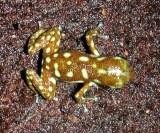Dendrobates arborea

Name: Dendrobates arboreus
French common name: Dendrobates tree
English common name: Polkadot Poison Frog
Spanish common name: Rana de punta de fleche arborea
German common name: Wipfelbaumsteiger
Legislation: CITES Appendix 2
Description:
Myers, Daly and Martinez, 1984. American Museum Novitates, New York, 2783: 5.
Holotype: The holotype 116724 is registered in the American Museum of Natural History (AMNH), New York, USA.
Systematic
Amphibia-> Anura-> dendrobatidis-> dart-> Dendrobates arboreus Myers, Daly, and Martínez (1984)
Group:
Dendrobates histrionicus
Description:
Base color black to brown with yellow dotted
Size:
20-22mm
Distribution:
This species lives in the west of Panama, bordering Costa Rica, the National Park La Amistad and Palo Seco Reserve at Lago Fortuna.
This species probably extends to Costa Rica, as La Amistad is located on the border.
Biotope:
Biotope in Lago Fortuna: At an altitude of 1000-1200m a harsh climate (for the tropics!). They live in the cloud forests. At night the temperature drops to 15 degrees and sometimes 10 degrees. On the day the temperature rises above 20 degrees, and when the sun appears sufffisament long, it can reach 28 degrees. Most of the time the clouds succeed in the treetops, or when it pours. After 30 minutes of sunshine, everything is already dry! This species lives at a height of 4 to 8m in the trees, mostly in large Bromeliads.
Terrarium / Layout:
Top terrarium in the center with a Bromeliad
ventilation (they live in the hills) and the possibility of high temperature at night cuts
rain and mist necessary
Temperature:
Day 20-26 ° C, night drop 4-5 ° C
Annual fluctuations: minimal (1-2 ° C)
Humidity:
70-80% a lot of fog, heavy rain
Power:
Usual small animals such as Drosophila, micro crickets, moths small hive, springtails, pre plankton.
Behavior:
Couple lives in large Bromeliads.
The population of Lago Fortuna was quite dense.
Windy, very cold or rainy, no song has been recorded! ditto weather too hot.
Reproduction:
it has a long courtship.
The eggs are placed on the leaves of bromeliads.
Tadpoles are fed by unfertilized eggs laid by the female.
The song resembles that of D.arboreus pumilios.



